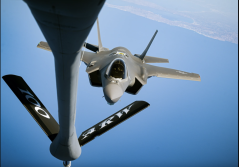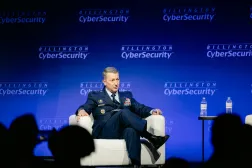Despite proposed cuts, Navy requirements for F/A-XX next-gen fighter ‘still valid,’ Joint Chiefs chairman says

The U.S. military’s top officer said Thursday that the Navy’s requirements for a next-generation stealth fighter jet are “still valid,” even though the Pentagon’s civilian leadership aims to cut the budget for the system while reassessing the program.
Congress funded the F/A-XX project to the tune of $454 million in fiscal 2025. However, the Defense Department wants to slash spending to just $74 million in 2026, according to budget documents viewed by DefenseScoop. Meanwhile, the DOD plans to spend $3.5 billion in the next fiscal year on the Air Force’s next-gen fighter, the F-47.
The 2026 request “slows” the Navy’s program “due to industrial base concerns of two sixth-generation programs occurring simultaneously,” according to the document.
Lawmakers this week expressed concern about the projected cuts.
“We know that in the FY ’25 [continuing resolution] there was $453.8 million … put towards that — I’ll get the number right — and in reconciliation $500 million. So you can see Congress is consistently pushing ahead and saying, ‘This is … where we need to go.’ And we’d be a little surprised if the support for this fell off, especially since we’re looking at the requirements and not seeing any change there,” Rep. Rob Wittman, R-Va., said Thursday during a House Armed Services Committee hearing.
Wittman asked Chairman of the Joint Chiefs of Staff Gen. Dan Caine, who was testifying during the hearing, if the requirements that military officials previously laid out for that platform are still the same.
“As we look at the threat picture out in the Pacific, the requirements themselves I think are still valid. I think it comes down to a question that many of the folks on the committee have talked about, and that’s the ability [for industry] to produce at a particular time. And I’ll defer to my civilian leaders on the timing and synchronization [of] that program. But we do need, you know, capability that is mobile, whether it’s F/A-XX or others, that enable us to win on the battlefield to the future,” Caine replied.
Secretary of Defense Pete Hegseth, who was testifying alongside Caine, said the fiscal 2026 budget request “funds the complete design of F/A-XX.”
However, he suggested the Pentagon is reevaluating plans for the program.
“We’re certainly reviewing it — working with the Joint Staff, working with the [combatant commands] — at its application around the globe. So it’s in the mix, but we recognize we need — we also need a capability as quickly as possible for the threats that we face,” Hegseth said.
Navy officials have said the F/A-XX is expected to be extra stealthy, have significantly longer range than the fighter jets that are currently in the fleet, and incorporate artificial intelligence capabilities.
The service also wants the manned jet to be able to team up with advanced drones.
“It will also, with the integration of AI and other technical advantages, allow us to have increased battle space management. And it will be our next platform that, instead of being man in the loop, will truly be man on the loop and allow us to have fully integrated architecture with our unmanned systems that we’re going to be fielding with concepts like the CCAs — whether it’s those collaborative combat aircraft, the small increased mass, or also teaming with larger unmanned vehicles that we may foresee into the future,” Rear Adm. Michael “Buzz” Donnelly, then-director of the air warfare division, N98, in the Office of the Chief of Naval Operations, said at the Navy League’s Sea-Air-Space conference in April.
At the same conference, acting Chief of Naval Operations Adm. James Kilby said the Air Force isn’t the only service that needs a sixth-gen fighter for a potential conflict against advanced adversaries like China.
“We need F/A-XX in the United States Navy,” he said. “We’re talking about a fight in the Pacific. We fight together as a joint force, so having that capability is very important for us.”
Many observers had expected the service to award a large development contract to either Boeing or Northrop Grumman in the spring.
However, Secretary of the Navy John Phelan, who stepped into his new role in March, told lawmakers Wednesday that officials continue to look at force structure needs for the future.
“As it comes to next-gen fighters … we’re looking at the full composition of the air wing of the future. And so we have to focus on the capabilities and technologies for years to come that are going to win, and that includes manned and unmanned platforms that we have to look at,” he said during a House Armed Services Committee hearing.
He noted that he also has concerns about the industrial base and how some of the Navy’s other programs are faring.
“I do not have a lot of confidence. All of our programs are in trouble. We have number of companies that are not performing. We’ve got to get those done. So I think looking at this system, sixth-gen is important. And I know it’s important to the admiral [Kilby], he should always give you his best military advice. I think we’re looking at the whole panacea of what we’ve got and then … what makes the most sense to use in the future. And so I think we have to get more confidence in the [industrial] base,” Phelan said.
“This is a system that you know, as I said in my opening statement about readiness, readiness means, like ready, like today and then in the future — and how is that future changing and how do we think about that? And so that’s we’re looking at it, evaluating it, and trying to make sure that we’re not back here in two years saying, ‘We told you it was going to cost X, it’s actually going to be X plus 50, and by the way, it’s going to be late,’” he told the committee.
Rep. Jen Kiggans, R-Va., said the Pentagon shouldn’t be cutting funding for the F/A-XX.
“We need that money for a lot of reasons,” she said at Wednesday’s HASC hearing. “China is … already testing and flying J-50s and J-36 fighters, which is their sixth-generation fighter. The Navy to be competitive with that has got to make that investment.”
The Trump administration has not yet submitted its full fiscal 2026 budget request to Congress. Lawmakers may end up appropriating much more money for the F/A-XX than the Defense Department proposes.






